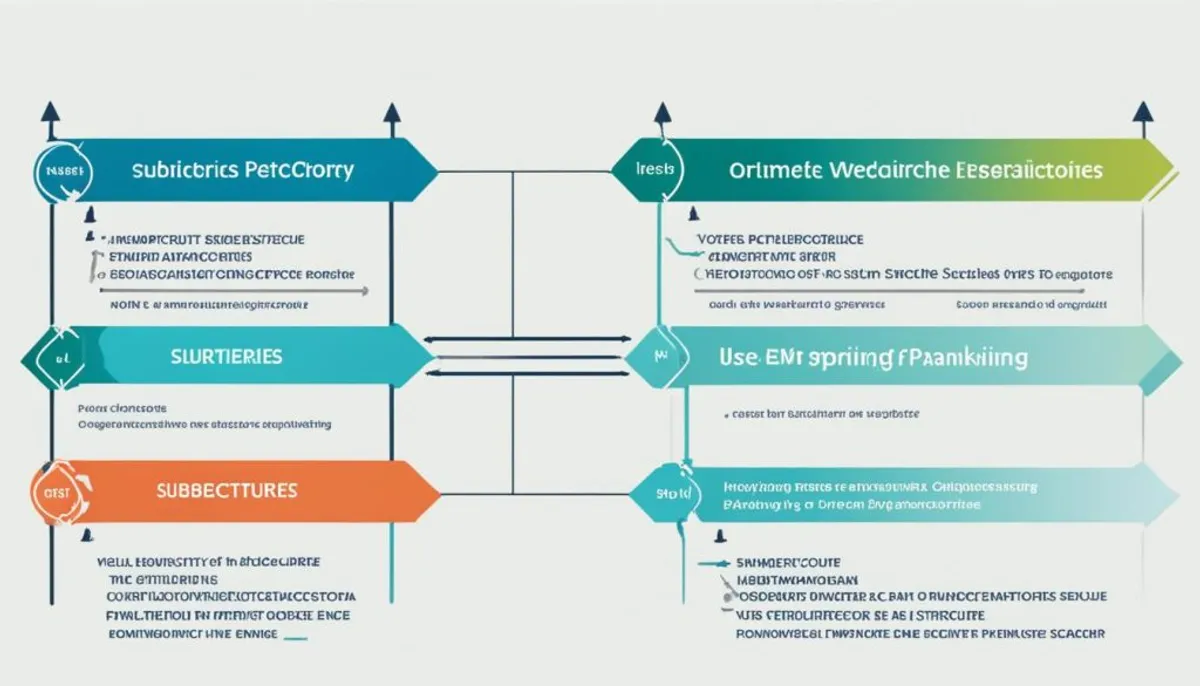A strong URL structure is key for your site’s success. It helps visitors find you on the web and makes your site better to use. To get the best results from search engines and bring in more visitors, it’s important to set up your URLs well. We’ll show you why URL structure matters for SEO and how to make your URLs work better.

Key Takeaways:
- SEO URL structure is essential for improving website visibility and user experience.
- Optimizing URLs can lead to better performance on search engine results pages.
- Following best practices and using relevant keywords in URLs can attract more organic traffic.
- Keeping URLs simple, reader-friendly, and descriptive improves SEO.
- Consider the role of top-level domains, subdirectories, ports, paths, query strings, and parameters in URL structure.
What is a URL Slug?
A URL slug is part of a website’s web address after the main domain. It’s like a page’s unique address. This address helps your browser or search engine find the specific page you’re looking for.
Knowing about URL slugs is important for making your site easy to find. By using simple and clear slugs, search engines can better understand what your site is about. This can boost your site’s ranking in search results, making it more visible to users.
Center image displaying a laptop with an optimized URL slug on its screen.
URL Slug Best Practices
Optimizing URL slugs for search engines is key to improving your website’s visibility. Following best practices ensures your URLs meet SEO standards and are user-friendly. Remember these tips when tweaking your URL slugs:
Keep it Simple
Make URL slugs simple by removing extra words and characters. This makes the link clean and easy to remember. Users are more likely to click on shorter, more concise links.
Include Relevant Keywords
Add keywords that describe your page’s content to the URL. But, don’t overstuff with keywords just for SEO. Quality content with the right keywords draws organic traffic.
Reader-Friendly and Understandable
Your URL slug should be easy to read and understand. It should give users an idea of what they’ll find on the page. Avoid technical terms that might confuse people.
Hyphens for Word Separation
Use hyphens to separate words in URL slugs for easy reading. Hyphens are better than underscores. Search engines tend to like them more.
Avoid Duplicate Slugs
Make sure each URL slug is unique. Using the same one for different pages confuses search engines and users. This confusion can hurt your SEO.
Avoid Dynamically Generated URLs
Avoid using URLs that change often. Static URL slugs work better for search engines and provide a stable user experience. Static URLs look cleaner too.
Following these best practices can enhance your website’s SEO. This will make your site more visible, bring in more visitors, and provide a smoother browsing experience for everyone.
How to Structure URLs for SEO
When aiming for a high rank on search engines, URL structure is key. By applying certain practices, you can boost your site’s visibility. This will draw in more organic traffic.
Describe Your Content Accurately
Describing each page accurately in your URL is vital. It’s best to use keywords that reflect the page’s topic. These keywords should come early in the URL. This method helps search engines understand what your page is about.
Include Keywords for SEO
Putting relevant keywords in your URLs can enhance their SEO. Select keywords that precisely show what your page is about. These should also be words your target audience commonly searches. Using these keywords in your URLs boosts your chances of showing up in the right search results.
Use Hyphens to Separate Words
Hyphens are ideal for breaking up words in your URLs. They boost readability for both people and search engines. For a great URL structure, steer clear of underscores or spaces. Use hyphens like so: www.example-website.com/seo-url-structure.
Use Lowercase Letters
Sticking to lowercase letters avoids confusion and ensures uniformity. This is because search engines view uppercase and lowercase letters as different. Consistent use of lowercase across your site is wise.
Keep URLs Short and Concise
Short and sweet URLs are not just good for users but also for SEO. They let search engines focus on your key terms. Users find shorter URLs easier to recall and share. This benefits everyone.
By adopting these SEO practices for your URLs, you can improve your website’s chances in search results. This leads to a more visible website, a better user experience, and potentially higher rankings. Following these tips is a smart move for any site owner.

Optimize your URLs for SEO to improve visibility and attract more organic traffic.
The Importance of Top-Level Domains (TLDs)
Choosing the right domain name is crucial for your online presence. The top-level domain (TLD) is the last part of your domain, such as .com, .org, or .net. It’s important for SEO and branding.
The TLD you choose should match your website’s goal and audience. There are various TLD categories:
- Generic TLDs (gTLDs): .com, .net, and .org are common examples. They’re great for many types of websites and build credibility.
- Country-Code TLDs (ccTLDs): TLDs like .us or .ca are specific to countries or regions. If you target a local audience, these can boost your local search visibility.
- New gTLDs: There are many new gTLDs like .online or .store available now. They can offer unique branding chances or interest specific markets.
Picking the right TLD is key for both improving SEO and standing out through branding. Here’s how:
Influence on SEO
The TLD choice affects how search engines see and rank your site. Google says all TLDs are equal, but well-known TLDs like .com might give a slight edge. For local targeting, using a ccTLD can help rank better in that area.
Remember, SEO success is about more than just TLDs. Your content, backlinks, and website’s usability are also critical for high rankings.
Branding Opportunities
TLDs are essential for building your brand’s identity. A good TLD tells users something key about your business. This can help them quickly understand your website’s focus.
For instance, if you have an online shop, a .store TLD shows that you sell items. A .org TLD, on the other hand, is trusted for nonprofit organizations.
Think about who you’re targeting and what message you want to send with your TLD. Making sure your TLD matches your branding, like your domain name and logo, is vital for a strong brand.
Choosing the right TLD is about your website’s goals, audience, and brand strategy. Knowing how TLDs affect SEO and considering your choices carefully, helps make a decision that supports your goals.
| TLD Category | Examples |
|---|---|
| Generic TLDs (gTLDs) | .com, .net, .org |
| Country-Code TLDs (ccTLDs) | .us, .ca, .uk |
| New gTLDs | .store, .online, .nyc |
The Role of Subdirectories in URL Structure
Subdirectories are key for a neat website address. They work like digital folders, grouping content tidily. This makes your URL easy to follow for visitors and search engines alike.
They are placed after the website’s name in a link. This shows the way to specific website sections or categories. It’s like creating a map for your content that everyone can understand.
Imagine a site for clothing. The ‘men’s,’ ‘women’s,’ and ‘kids’ sections are main subdirectories. Inside, you can have more for ‘shirts,’ ‘pants,’ or ‘accessories.’ This structure guides visitors directly to what they want to see.
Duplicate subdirectory setups are a big no. They confuse users and search engines. They can also cause problems with showing up in search results. So, keep it unique and clear.
Benefits of Well-Structured Subdirectories:
- Improved site navigation: Subdirectories help users navigate through your site by providing a logical structure and clear pathways to desired content.
- Enhanced content organization: By organizing your content into meaningful groupings, subdirectories make it easier for both users and search engines to understand the hierarchy and relevance of your pages.
- Optimized SEO: A well-structured URL with descriptive subdirectories can improve your website’s visibility in search engine results and increase the likelihood of attracting organic traffic.
Using subdirectories makes your site both user and search engine friendly. Make sure they are well-organized and unique. Also, use names that show what’s inside clearly.

| URL Example | Description |
|---|---|
| https://www.example.com/mens/shirts/t-shirts | A subdirectory structure that organizes men’s clothing, specifically shirts, into the category of t-shirts. |
| https://www.example.com/womens/dresses/summer | A subdirectory structure that categorizes women’s clothing, specifically dresses, under the summer collection. |
| https://www.example.com/kids/shoes | A subdirectory structure that groups children’s footwear into a dedicated shoes category. |
Understanding Ports in URLs
Ports are like a technical doorway in website communication. They help requests and responses get from the client to the server and back. Ports are key for a strong, fast connection.
Moving on to URLs, they often use standard ports. For example, 80 is the standard port for HTTP, and 443 is for HTTPS. When a URL doesn’t specify a port, 80 is the default assumption.
Sometimes, though, websites might need to use custom ports. Custom ports let various web services run on just one IP address. This can save money, as it means you don’t have to set up new infrastructures.
Knowing about ports is key, especially for search engine crawling. Search engines crawl the web by sending requests through ports. To make sure your site is easily found and explored, check that the right ports are open for search engines.
Standard Ports for Common Protocols
| Protocol | Standard Port |
|---|---|
| HTTP | 80 |
| HTTPS | 443 |
| FTP | 21 |
| SMTP | 25 |
| POP3 | 110 |
By using ports well, you make your website’s communication better. This helps search engines understand your site and ensures your website runs smoothly.
The Significance of URL Paths
The URL path is key for moving around a website and for SEO. It shows the specific location of a page or file after the main web address. This guide helps people and search engines find the right content.
URL paths show the route to a page or file and can be deep. They use words and hyphens between slashes. These paths should say what the page is about to help search engines know its topic. Putting important words in the URL can make your page show up better in searches.
Choosing a unique URL path is vital to not have the same content twice on your site. Search engines treat each URL as a new page. Making smart paths can also make your website look more organized. It’s a double win for helping visitors and search engines.
In web servers, URL paths are picky about uppercase and lowercase letters. So, /products and /Products are not the same. For easy management, always go with lowercase letters in your URL.
So, the URL path is super important for your site’s web address setup and for SEO. With the right URL paths, you make it easier for people and search engines. This equals more visitors and a better website experience.
Utilizing Query Strings and Parameters in URLs
Query strings and parameters are key in website development and SEO. They make data passing and customization easy. This boosts the web’s functionality and user experience. Knowing how to use them is vital for making your site perform well and improving SEO.
Query strings hold field and value pairs added to a URL. They send data to servers, useful for personalizing pages or tracking analytics. For instance, they can show products on a shop’s site that match what a user has searched for.
URL parameters add extra info to a server. They sit within the URL and change what’s shown. You can change language settings or show only some part of a page using them.
But, using query strings and parameters well is also about SEO. Dynamic URLs from them might create duplicate or too many changing URLs. This confuses search engines, affecting a site’s ranking. To handle this, use correct URL editing and pick the right keywords for your links.
“Query strings and parameters make URLs do more, but watch out for SEO troubles if you don’t handle them right.”
Here are tips for using query strings and parameters well:
- Choose names for query strings and parameters that clearly say what they do.
- Make sure your URLs look right by encoding them. This solves issues with special characters or spaces.
- Don’t overdo it with query strings and parameters. Use them when they’re really needed.
- Short URLs are generally better for SEO, so keep that in mind.
Follow these suggestions to make the most of query strings and parameters. They’ll help you build URLs that are both dynamic and SEO-friendly.
| Pros | Cons |
|---|---|
| Enables dynamic data passing | Potential for duplicate or changing URLs |
| Allows for customization and personalization | Can impact search engine rankings if not managed properly |
| Enhances user experience and functionality | Requires proper URL canonicalization |
Conclusion
Optimizing your URL structure is key for SEO success. Keeping URLs simple and easy to read is crucial. It also helps to add important keywords.
Think about the top-level domains and other parts of URLs too. They impact how people find and use your site. Usability and sharing valuable info are essential.
Take time to improve your URL setup. Focus on making it part of your SEO plan. A well-organized URL helps your site do better. It boosts how often people see and like your site.
FAQ
What is the importance of URL structure in SEO?
URL structure is key in making a site more visible and user-friendly. It enhances SEO, helping your site rank higher in searches. By optimizing URLs, you can attract more visitors organically.
What is a URL slug and why is it important?
A URL slug is the unique part of a URL that comes after the domain. It highlights a page’s content distinctly. Knowing about URL slugs helps make your site more SEO-friendly.
What are some best practices for creating URL slugs?
Keep your URL slugs short, clear, and keyword-rich. Use relevant words and avoid overloading with keywords. Make them easy to read, and ensure they are unique. This makes your site more consistent and appealing to search engines.
How should URLs be structured for SEO?
For good SEO, craft URLs that describe what’s on the page. Put important keywords near the start and use hyphens to separate them. Keep URLs brief, lowercase, and focused on users and keywords.
What is the significance of top-level domains (TLDs) in URL structure?
TLDs show what category or region a site is for. Picking the right one helps SEO and your brand. Knowing about TLDs guides smart choices for your website.
How do subdirectories impact URL structure and SEO?
Subdirectories categorize your site’s content. They appear after the domain like folders on a computer. Clear subdirectories mean better navigation and understanding by search engines.
What is the role of ports in URLs and why are they important?
Ports in URLs show the channel for data exchange between servers and clients. They affect how well search engines explore your site. Knowing about ports can help maintain good SEO and site speed.
What do URL paths indicate and why are they significant?
URL paths show a page or file’s location. They guide search engine understanding. Unique paths stop duplicate content and remember, cases in paths can matter to servers.
How can query strings and parameters impact SEO and URL structure?
Query strings and parameters shape URLs dynamically. They’re useful, but too many can confuse search engines. Manage them to maintain steady SEO rankings.
RelatedRelated articles



